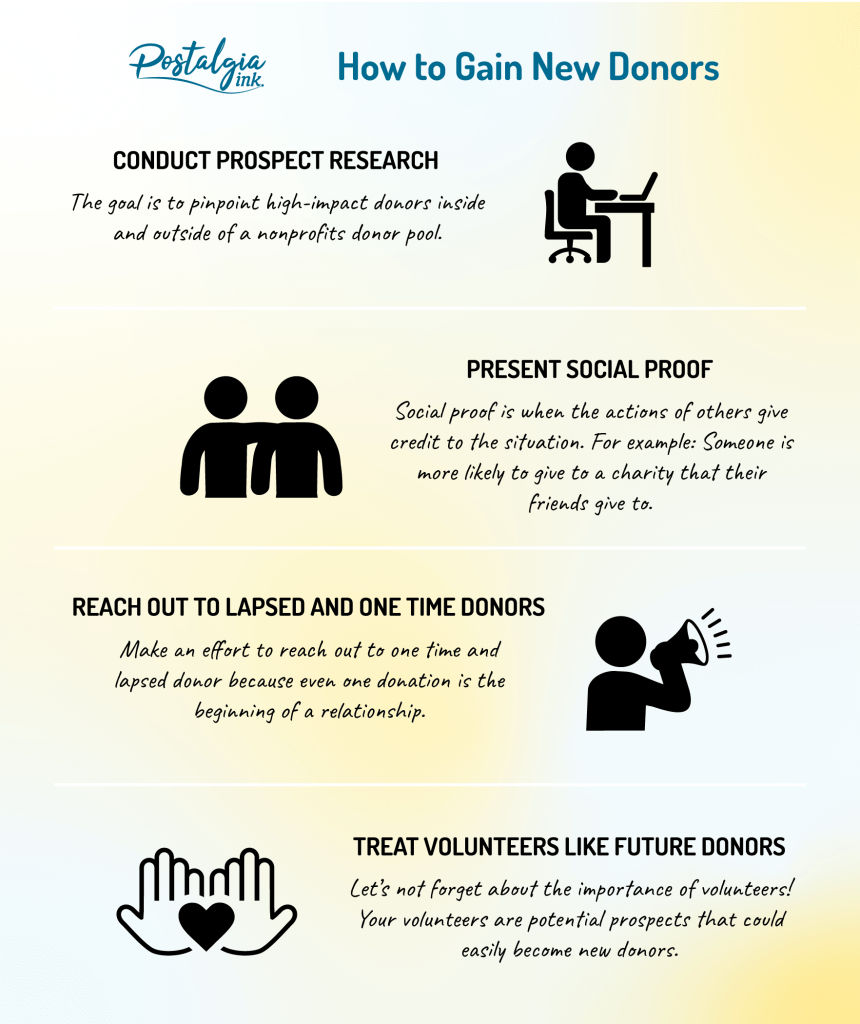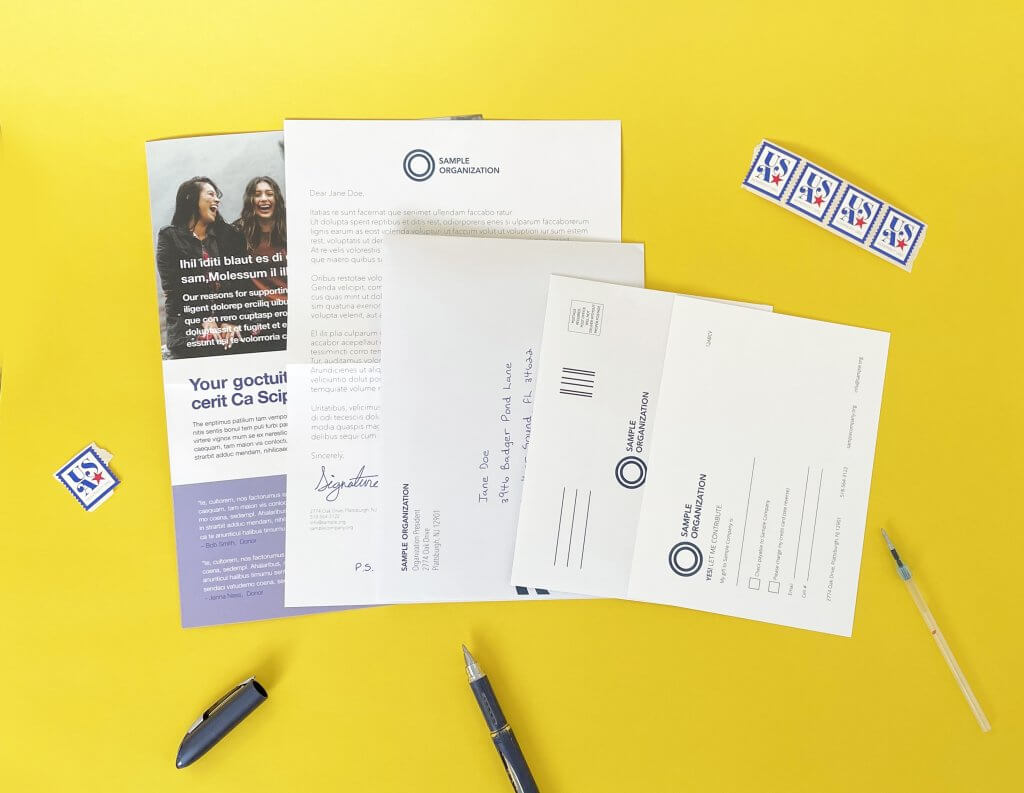How to Gain New Donors
By: EmMa Matern
February 1, 2023According to the 2022 Third Quarter Fundraising Report (FEP), there has been an increase in donations by 4.7%, but a decrease in the number of donors by -7.1% a continuing trend. Nonprofits will have to rely on the bulk of their donations coming from fewer donors.

Consistent and reliable incoming funding is at risk. Although charitable giving increased in 2022, the number of donors decreased. It’s important in 2023 to make an effort to keep up your organization’s number of donors. We have covered Donor Retention in the past but now it is also mission critical to increase donation numbers by gaining new donors.
So let’s walk through how you can conduct prospect research, present social proof, reach out to one time and lapsed donors, and the importance of treating your volunteers like future donors.

CONDUCT PROSPECT RESEARCH
Prospect research can be referred to by a few names: donor prospecting, screening, or donor research. This research technique is used by major gift organizers, nonprofit fundraisers, and development teams. Their goal is to pinpoint high-impact donors inside and outside of a nonprofits donor pool.
Benefits of Prospect Research:
- EVALUATE DONORS: There could be potential major donors within your donor pool
- FIND NEW PROSPECTS: Expand your reach by researching for potential donors
- REVISE GIFT STRATEGY: By screening your prospects, you can build a robust gifting system based on donors that are more likely to donate
- ENHANCE FUNDRAISING ACTIVITIES: Analyze donor data to highlight fundraising trends to create successful activities
- DISCOVER CORPORATE GIVING OPPORTUNITIES: Discover donors with eligible corporate giving incentives such as – volunteer grants and matching gifts
- FILL GAPS IN DONOR DATA: Update outdated and empty donor information
Types of Prospects:
- Individual Donors: One time, annual, recurring
- Major Donors
- Corporate Donors
- Foundations
How to do prospect research:
- In-house prospect research: Staff member or full-time research staff take on the responsibility of conducting prospect research
- Work with prospect research consultant
- Partner with prospect research screening company

PRESENT SOCIAL PROOF
Showing social proof is an authentic technique to attract new donors. In an article by Alfred Lua from Buffer.com, social proof is a psychological phenomenon when the actions of others give credit to the situation. For example: a potential donor is more likely to give to a charity that their friends also give to.
There are a few types of social proof: Expert, Celebrity, User, Crowd Wisdom, Friend Wisdom
5 types of social proof in the nonprofit industry with example:
Expert: Doctor who works for a hospital explaining allocation of donations and how it has helped patients
Celebrity: Public figure that has an affiliation with organization and donates on a regular basis
User: Community testimonials
Crowd Wisdom: Showing number of donors
Friend Wisdom: A friend that donates to a specific charity
Showcasing social proof can be done in a multitude of ways, whether you keep it simple and show more depth. You can include community testimonials in your direct mail campaign, post a video of a volunteer talking about their experience with your nonprofit on social media, or even have a recipient tell their story at a fundraising event. Storytelling is perhaps the most powerful form of social proof. It can evoke emotion in potential donors that leads to them feeling more passionate about the cause.

REACH OUT TO LAPSED AND ONE TIME DONORS
Circling back to the statistic above proving that charitable giving increased in 2022, but the number of donors decreased. It is vital to be cautious if you only rely on a small percentage of major donors and to remember that small donors are important too.
Make an effort to reach out to one time and lapsed donor because even one donation is the beginning of a relationship. It goes a long way to communicate to donors and let them know they helped out, and that they are a part of the cause. Nurturing your relationship to small donors will go a long way with maintaining incoming donations. Your solicitation endeavours to one time donors could turn them into recurring donors. Invest in your relationships with big and small donors.

TREAT VOLUNTEERS LIKE FUTURE DONORS
Let’s not forget about the importance of volunteers! Your volunteers are potential prospects that could easily become new donors. They have an established relationship with your organization and have already displayed their passion and commitment to the cause. Always remember to follow up with your volunteers because they are what keeps your nonprofit organization going. By staying connected to your volunteers, you are strengthening the relationship and giving them a memorable experience with your organization. This goes a long way for their future as a donor.
Deliver a personalized follow up to your volunteers as a gesture of gratitude. There are various ways to communicate with volunteers, a phone call, an email, or a personalized handwritten letter or note. The more genuine, the better. Timing is also key, so ensure to follow up as soon as possible after an event or campaign.
What to include in a follow up:
- A heartfelt handwritten thank you
- Their impact on the cause
- A way to provide feedback (survey, email address, phone number, etc)
FINAL THOUGHTS
With the increase of giving but decrease in number of donors, donation stability is at risk in 2023. The focus this year should be on gaining new donors. The strategies we discussed are improving your donor data by conducting prospect research, presenting potential donors with social proof to show legitimacy, making an effort to maintain a relationship with lapsed and one time donors, and treating your volunteers like future donors.
